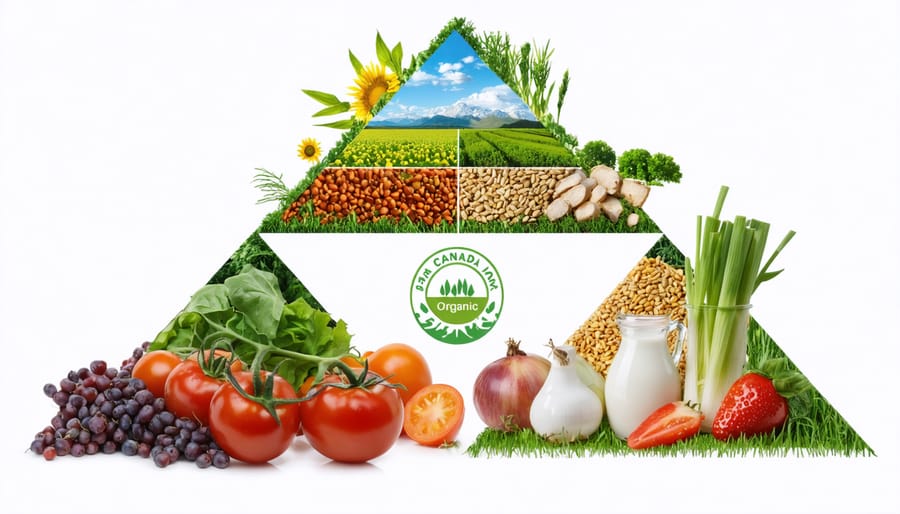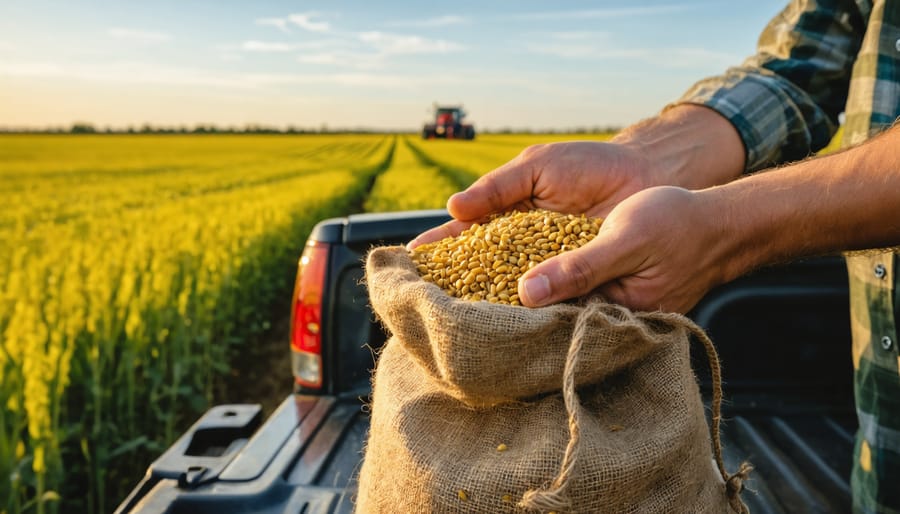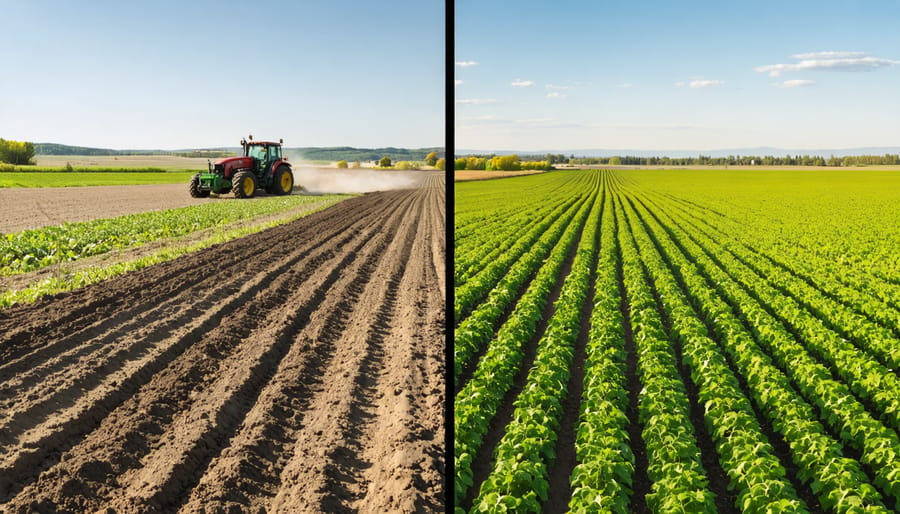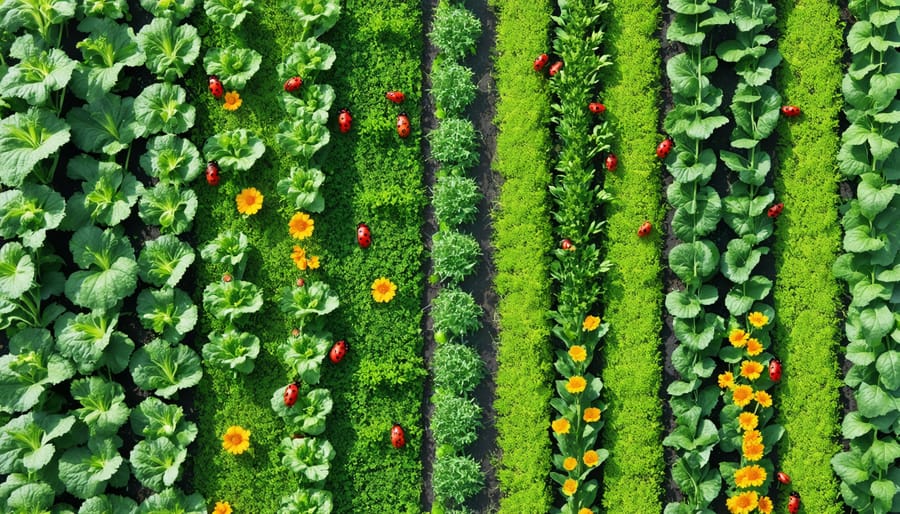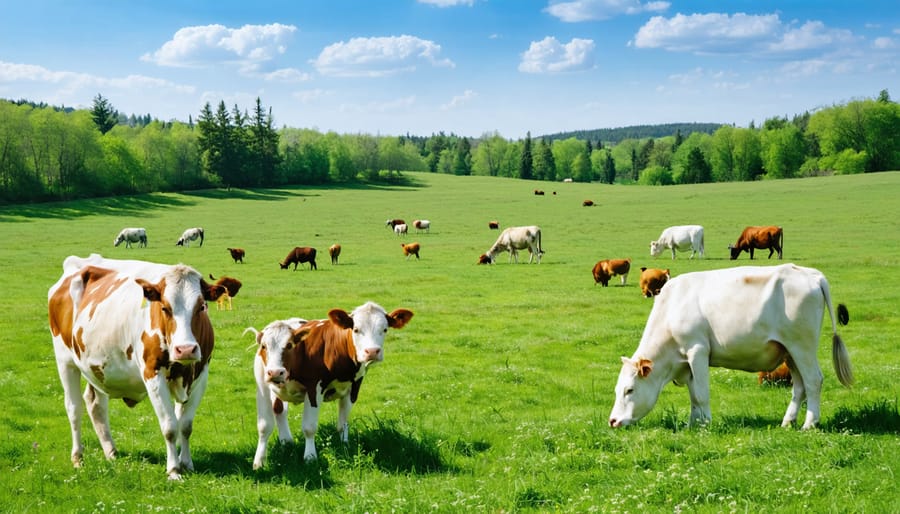Transform your daily meals into a powerhouse of nutrition by mastering Canada’s modernized food pyramid, a practical guide that connects Alberta’s farmers directly to your plate. Each of the seven essential food groups – vegetables and fruits, whole grains, proteins, dairy, healthy fats, legumes, and water – forms a crucial building block for optimal health while supporting our local agricultural community.
From the sun-ripened tomatoes of Southern Alberta’s greenhouses to the protein-rich pulses of the prairie provinces, our food pyramid reflects both time-tested nutritional science and the rich diversity of Canadian agriculture. Understanding these food groups helps bridge the gap between farm-fresh production and mindful consumption, ensuring both environmental sustainability and optimal nutrition.
Recent studies from Agriculture Canada show that households following the pyramid’s guidelines while choosing local, seasonal products reduce their carbon footprint by up to 25% while maximizing their nutritional intake. Whether you’re a farmer planning crop rotations or a consumer making weekly grocery decisions, this fundamental framework serves as your roadmap to better health and sustainable food choices.
Understanding the Modern Food Pyramid in Organic Context

The Evolution of Food Guidelines in Canadian Agriculture
Canada’s food guidelines have undergone significant transformation since their inception in 1942, reflecting our growing understanding of nutrition and sustainable agriculture. The shift toward organic considerations began in the early 1990s when farmers and consumers started to identify organic foods as an important aspect of healthy eating.
In 2019, Health Canada introduced a revolutionary update to the traditional food pyramid, replacing it with a plate-based model that emphasizes plant-based proteins and locally sourced produce. This change particularly resonated with Alberta’s farming community, as it aligned with the growing trend toward sustainable agricultural practices.
The guidelines now incorporate organic certification standards, encouraging farmers to consider environmental impact alongside nutritional value. For Alberta producers, this has meant adapting traditional farming methods to meet organic requirements while maintaining productivity. These changes reflect a broader shift in Canadian agriculture, where environmental stewardship and nutritional quality are increasingly viewed as complementary goals rather than competing interests.
Grains and Cereals: The Foundation
Alberta’s Organic Grain Revolution
The organic grain movement in Alberta has seen remarkable growth over the past decade, with pioneering farmers leading the charge toward sustainable agriculture. Alberta’s sustainable grain farming practices have transformed traditional wheat and barley fields into thriving organic operations.
Take the Morrison family farm near Red Deer, for example. Their 800-hectare operation transitioned to organic in 2015, and now produces premium organic wheat, oats, and ancient grains. By implementing crop rotation and natural pest management, they’ve increased soil fertility while reducing input costs by 40%.
In the Peace River region, the Cooper Valley Cooperative, representing 12 family farms, has successfully converted 2,000 hectares to organic production. Their collective approach to marketing and knowledge-sharing has created a resilient model for other farmers to follow.
These success stories demonstrate how organic grain farming not only supports the environment but also offers viable economic opportunities for Alberta’s agricultural community. With increasing consumer demand for organic grains, more farmers are exploring this sustainable path forward.

Fruits and Vegetables: The Color Spectrum
Local vs. Imported Organic Produce
When choosing organic produce, Albertan farmers and consumers often face the decision between local and imported options. While both support sustainable agriculture, each offers distinct benefits. Local organic produce typically travels fewer kilometers, reducing transportation emissions and supporting regional farmers. These products often reach markets within 24-48 hours of harvest, ensuring peak freshness and nutritional value.
However, imported organic products help maintain year-round availability, especially during Alberta’s winter months when local production is limited. They also support global organic farming communities and may offer varieties that don’t grow well in our climate. For optimal balance, consider seasonal eating patterns – prioritize local organic produce during growing seasons (May through October) and supplement with imported options during off-seasons.
Many Alberta farmers’ markets now feature certified organic vendors, making it easier to connect directly with local producers. Look for the Canada Organic logo and ask about farming practices to make informed decisions that align with both environmental and community values.
Protein Sources: Beyond Meat

Canadian Organic Protein Production
Canadian farmers are leading the way in organic protein production, with Alberta’s farmers contributing significantly to the nation’s organic livestock and legume sectors. Local producers follow strict organic certification standards, raising cattle on natural pastures and growing protein-rich crops like lentils, peas, and soybeans without synthetic pesticides. These practices not only support soil health but also meet the growing consumer demand for clean protein sources.
Many Alberta farmers have successfully transitioned to organic methods, implementing rotational grazing systems and growing diverse protein crops. For example, the Prairie Organic Grain Initiative reports that organic pulse production has doubled in the past five years, offering farmers sustainable income opportunities while providing high-quality protein options for Canadian consumers. Farmers working with heritage livestock breeds and traditional farming methods have found particular success in organic meat production, creating premium products for local and international markets.
Dairy Products: Quality Indicators
Quality indicators for dairy products start with understanding organic certification standards and their impact on nutritional value. For Alberta dairy farmers, key quality markers include proper animal welfare practices, grazing requirements of at least 120 days per year, and the absence of artificial hormones and antibiotics. Fresh milk should have a clean, sweet smell and maintain a consistent colour throughout, while yogurt should display a firm texture without excessive liquid separation.
When selecting organic dairy products, look for the Canada Organic logo and certification number. Premium-quality organic butter should have a uniform yellow colour and firm texture at room temperature. For cheese, proper aging conditions and consistent texture indicate high-quality production methods. Local dairy cooperatives in Alberta often exceed these baseline requirements, implementing additional quality controls such as regular bacterial count testing and stringent cold chain management.
The shelf life of properly stored organic dairy products typically ranges from 14 days for fluid milk to several months for hard cheeses, reflecting both the production standards and handling practices of our local dairy industry.
Fats and Oils: Making Healthy Choices
In organic agriculture, the quality of fats and oils starts right in our Canadian fields. Cold-pressed canola oil from Alberta’s pristine farmlands leads our local options, offering a heart-healthy choice rich in omega-3 fatty acids. Traditional favorites like grass-fed butter and organic ghee provide essential nutrients while supporting local dairy farmers. When selecting cooking oils, look for those certified organic and minimally processed – extra virgin olive oil, coconut oil, and flaxseed oil are excellent choices. For optimal freshness, store oils in dark containers away from heat and light. Many Alberta farmers are now producing these specialty oils, creating a sustainable local market while ensuring premium quality. Remember to consume these foods in moderation, aiming for about 2-3 tablespoons daily of high-quality oils.
Practical Implementation Tips
To effectively incorporate organic foods into your daily meals, start by identifying local organic farmers’ markets and Community Supported Agriculture (CSA) programs in Alberta. Plan your meals around seasonal produce to ensure freshness and support regional farmers. When shopping, look for the Canadian organic certification logo to verify authenticity.
Create a weekly meal plan that incorporates items from each food group, prioritizing organic whole grains, legumes, and locally-grown vegetables. Consider dedicating a portion of your farm or garden to growing organic vegetables, which can supplement your family’s needs while providing valuable farming experience.
For protein sources, connect with local organic livestock farmers or explore options for raising your own grass-fed cattle or free-range chickens. Store organic produce properly to extend shelf life – root vegetables in cool, dark spaces and leafy greens in the refrigerator with proper humidity control.
Start small by converting one meal per day to fully organic ingredients, then gradually increase as you establish reliable supply chains and develop preservation techniques. Remember that successful organic implementation often relies on building strong relationships with fellow farmers and suppliers in your community.
Understanding and implementing the food pyramid principles is essential for both sustainable farming and healthy eating practices. As Alberta’s agricultural community continues to lead in sustainable food production, we’ve seen how integrating these nutritional guidelines strengthens our local food systems. By prioritizing diverse crop rotation and supporting local organic producers, we’re building resilience in our food supply while promoting better dietary choices. Remember that each food group plays a vital role in both agricultural diversity and human nutrition. Let’s continue working together to produce and consume food that benefits our communities, supports our farmers, and protects our environment for future generations. Through mindful choices in both farming and eating, we can create a more sustainable and healthier food system across Alberta and beyond.

